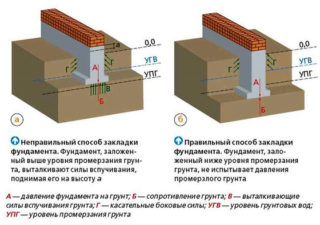The foundation absorbs the loads from the building and distributes the forces evenly to the foundation. The foundation for the fence will protect the fence from distortions, breaks and deformations. The base is a concrete strip with square extensions for posts made of brick or concrete. Metal posts do not require an increase in the size of the support strip.
The need for a foundation for a fence
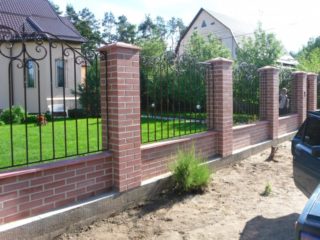
A solid foundation is an integral part of the fence, especially if the fence is heavy. Reasonable use of the material involves the construction of the foundation in accordance with the needs. For example, metal racks with mesh require pouring only under the pillars, and solid concrete tape will cause cost overruns.
Support in the ground will become indispensable in such cases:
- there is unstable soil on the construction site;
- the fence is installed near a river or other body of water;
- there are strong winds in the area, the house is located in an open area.
Under the brick pillars of the fence, the base is made wider in the plane and deepens in comparison with the concrete tape. A semblance of a pile is made, the base of which is 20 cm below the main strip.For the fence on the strip foundation, a trench 20 cm wide and 50 cm wide is made.Under the pillars, the cross-section in the plan is 40 x 40 cm, and the depth increases to 70 cm.
The foundation is reinforced with a frame with rods 8 - 10 mm thick. For the crossbars, rolled metal 6 mm is taken, the jumpers are placed in increments of 40 cm. The joints of the reinforcement are welded, connected with knitting wire or plastic clips. The gate supports are connected to the reinforcement frame in the foundation body.
Parameters affecting the depth of the foundation
The depth of the laying is determined taking into account the factors:
- design feature of the fence;
- the weight of the fence and the magnitude of the load;
- land relief and soil category;
- standing height of ground moisture;
- freezing mark in winter.
Under the sections of the corrugated board between the heavy posts, the depth of the laying is reduced, and under the basic elements, the concrete tape under the fence is made lower. This method saves resources and reduces labor costs in the process of excavation and concreting. The index of soil freezing is determined by the type of soil in special tables of the construction area.
The base is deepened 30 - 40 cm below this indicator for massive barriers made entirely of brick or concrete, while the width of the support should not be less than the width of the wall. The freezing mark is not taken into account when building on rocks, in which case the foundation is deepened by the size of the immersion of the posts (50 - 70 cm).
Types of foundation for a fence
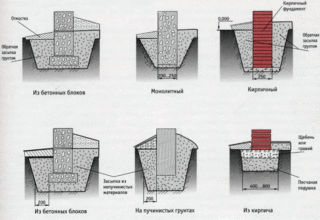
The type of support depends on the material of the fence. Columnar and monolithic foundations are used in different cases, depending on the severity of the fence. Correct calculation along with high-quality materials will lead to the creation of a solid foundation and a long service life of the fence.
The choice of design is influenced by:
- uniformity of the structure of the fence in terms of;
- the presence of massive pillars;
- soil stability and moisture.
Insufficient height or width of the base will not allow to withstand the efforts, so the fence may fall after a frosty winter. The base sags due to its mass, soil shifts under load, cracking as a result of freezing and thawing cycles (if the freezing depth is not taken into account).
The basis is:
- columnar;
- monolithic;
- masonry;
- tape type.
The different form of the foundation allows you to find the best way to counteract negative factors and preserve the integrity of the fence. Concrete belts are continuous and intermittent, and prefabricated prefabricated glasses are used under the pillars of the gates and columns. A prerequisite is welding of the outlets with the reinforcing frame of the monolithic section. Builders save material by using combined structures.
Column fill
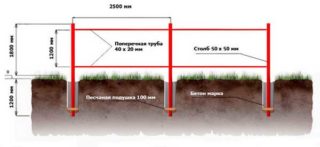
The pillars are exposed at a distance of 1 - 4 m, square pits are dug under them to a depth of 0.8 - 1.2 m. At the bottom, filling is made of compacted sand, crushed stone or gravel. For strength, a volumetric metal frame is made of reinforcement, in the center of which a support element of the fence is placed. The verticality of the installation is checked using a plumb line in perpendicular planes.
Concrete is poured in layers into the space between the elements, each layer is vibrated with an electric tool. Air bubbles weaken the concrete mass, so they need to be driven out of the solution. If the fence is made of corrugated board, the posts are placed every 2 m, since the material has a high wind capacity and the wind load increases.
The positive sides of the columnar base for the fence:
- profitability - the solution fits only in the places of the support posts, and not along the entire length of the fence;
- ease of installation - no skilled workers are required;
- duration of operation - the pillars are not destroyed and serve up to 30 years.
The columnar base is made for fences made of chain-link mesh, wooden lattice, picket fence, metal profile, siding. They work well in clayey soils. The bottom (heel) can be extended if the soil is in the heaving category.
Monolithic fill
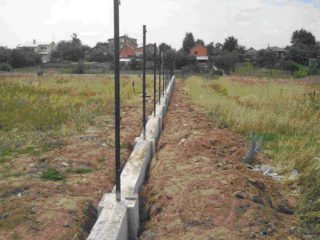
This design includes the simultaneous operation of the pillars together with the concrete base. The option is used for heavy fences made of monolithic concrete, brick, natural stone, which are built on swampy lands, in permafrost conditions or quicksand. The combined action of the tape and the pillars, poured at the same time, makes it possible to withstand the loads from the wall, wind forces, the weight of the supporting pillars, and prevents soil shifts.
To build such a foundation for a fence, follow the step-by-step instructions:
- A common tape trench is dug to a depth of 50 cm around the perimeter in accordance with the diagram and drawing. The width is determined in accordance with the transverse dimension of the fence.
- The position of the fence posts is marked, and the soil is dug out for deepening. The size of the pit is 40 x 40 cm, and the step of the supports is taken from 1 to 2.5 m. The earth is removed by 1.5 meters.
- A sand and gravel cushion is made. The pillars are installed in the pits and 2/3 are concreted.
- Reinforcement mesh is laid in longitudinal trenches. If necessary, formwork is made or pouring goes directly into the ground.
To prevent moisture from leaving the concrete into the wood or earth, lay a film on the sides of the trench.Formwork is needed if the base is 10 cm above the ground surface.
Stone base
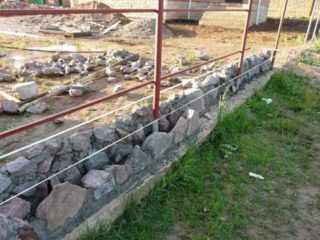
The bottom of the fence made of natural stone looks advantageous in combination with solid materials, for example, forged lattice, carved wood. For a fence made of lightweight corrugated board, such a base is not used. The stone belt is the base of the fence, which rises 0.7 - 1.0 m above ground level. Such a foundation is not buried in the ground.
The perimeter of the laying is preliminarily leveled, boulders are used, reinforcement for the bundle is placed inside the masonry. In the body of the stone basement, metal rods or other embedded parts are vertically installed for the subsequent fastening of the upper fence. A solid foundation can be made with your own hands if the person is familiar with such work.
The stones have different sizes and shapes, so attention is paid to the joints of the elements. Large parts are combined with small ones so that voids are not created. The stones are placed on a cement-sand mortar, concentration 1: 3 (cement, sand, respectively). The masonry mass is immediately removed from the surface of the stone, otherwise, after adhesion, it is difficult to remove it from an uneven area. Elements turn with their attractive side outward, if the inside of the fence is not particularly important.
Tape base

A common version in the form of a concrete tape is performed under the perimeter of the fence. The foundation is easy to do with your own hands if you have a little experience with concrete and dredging. It is a strip base for massive and heavy fencing structures. The depth is determined by the type of soil. A reinforcing cage is placed in the body of the tape, without which the foundation will crack after the first winter.
The tape base is performed:
- shallowly buried;
- buried.
The first option is built in soil with stable characteristics. The second type is intended for unstable soils, but is rarely done deeper than 0.7 m, even if the fence with a strip foundation is of great height. The belt structure can be monolithic or contain precast concrete blocks.
Advantages of the tape type:
- simplicity of construction - no special equipment is needed, the marking is done manually, like digging a trench, preparing concrete and pouring;
- low cost of construction - simple materials are used, dimensions do not imply excessive consumption of cement, sand, crushed stone and metal;
- the speed of making the base - together with the digging of the trench, the period takes no more than 4-6 days.
The base tape is made for fences made of different materials that have weight or strong windage.
DIY construction technology

Before starting the construction of the foundation, you need to calculate and draw the elements of the fence. Sheets of corrugated board, slate have dimensions that are taken into account when marking supports. Columnar foundations are made in the recesses of trenches in strictly defined places, so later it will be too late to redo the structure of the fence, taking into account errors.
For foundations, concrete of the M300 or M200 brand is made, this composition is recommended by experts for the foundation under the fence. The protruding top of the base is painted in a suitable or contrasting color compared to the filling of the fence. Such a foundation is decorated with tiles, ceramics, natural materials.
Step-by-step instruction
The ditch is dug manually or with an excavator. In the second option, you will have to clean the bottom and level the longitudinal walls after the machine is running. A layer of crushed stone and sand with a thickness of 10 - 15 cm is laid, which is spilled with water and rammed with hand tools.
Instructions for the device:
- The formwork is made of boards or chipboard sheets, impregnated OSB. You can use materials at hand, for example, door leaves, sheets of flat slate, furniture panels. Shields are fastened together and fixed to the frame. On the outside, stops and braces are placed so that the concrete does not collapse the structure.
- A volumetric frame made of metal rods is placed in the formwork; a corner, a strip can be used for longitudinal elements. The elements are connected by welding or knitting. For light fences, flat longitudinal reinforcement meshes can be used.
- Concreting is done in layers. If you need to leave the work front for tomorrow, a runaway (a kind of ladder) is performed at the site of the future joint, since there should be no vertical seams. A vibrator is used after each styling to get rid of the air inside.
In summer, on the second day, the top of the foundation is covered with a layer of sawdust to prevent the surface from drying out and the appearance of small cracks. The shavings are moistened daily with a watering can.
Concrete hardens on the second day after pouring, and gains 100% strength after 28 days. The formwork is removed every other day, and the structure can be loaded only after 2 weeks.

